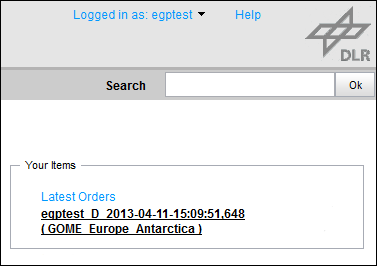Find and Download Catalog Products¶
The Collections Tab¶
On the collections tab you will see the first subset of entries of the complete EOC Catalog, which you may restrict by applying up to four different filters.
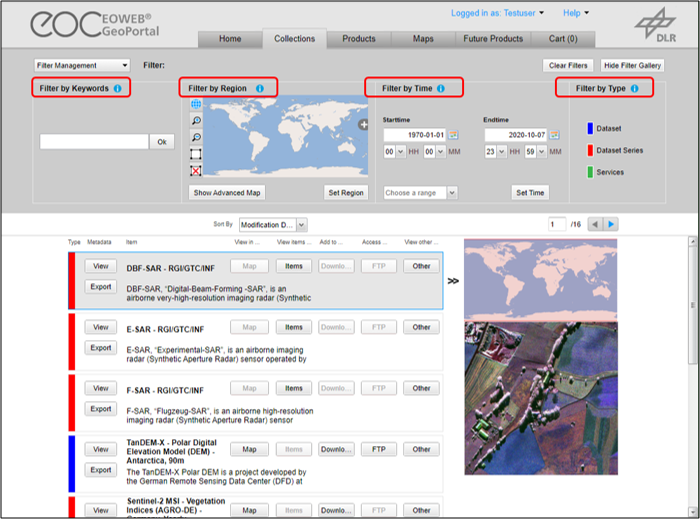
Additional information for each filter is available.

Filters¶
On the collections tab, filters may be activated and deactivated anytime, any number from zero to four and in any sequence.
Specified filters are displayed as buttons at the top of the tab.
Remove the filter by clicking on the “X” to the left of the filter button.
Moving the mouse over a filter button shows the actual filter settings as tooltip.
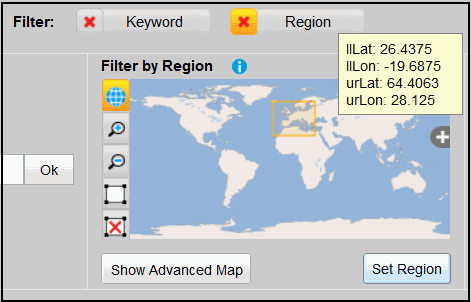
Filter by Keyword¶
You may apply domain-specific keywords like elevation, atmosphere, or crisis information to reduce the number of catalog results.
Click on the edit field to bring up a list of selectable keywords and start typing to reduce them.
To select, click on a keyword or press Enter.
If there is no suitable predefined keyword, you may also enter free text for a full text search.
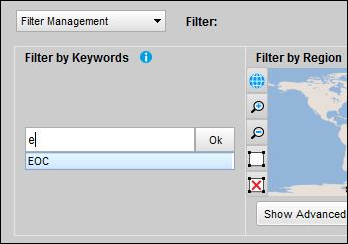
The keyword filter is applied immediately on clicking on its activation button.
To remove the filter, click on the “X” to the left of the filter button.
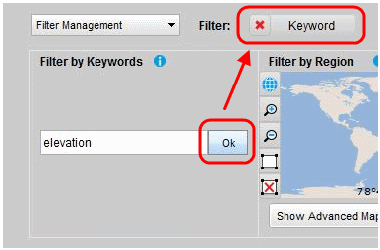
Filter by Region¶
You may reduce the number of catalog entries displayed by restricting the area of interest (AOI). This can be done by drawing a rectangle, by selecting a predefined region, by inserting coordinates of a bounding box, by importing an AOI or by searching a location.
Specifying an AOI by drawing: Click on the draw button and draw a rectangle by click-and-drag.
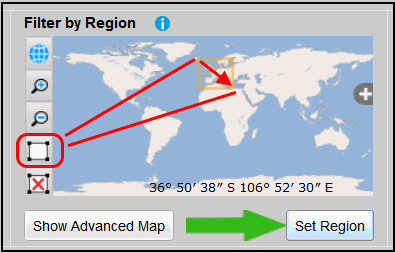
Redraw by just repeating the procedure and “Set Region” activates the region filter.
Move the map by click-and-drag when the draw button is not selected.

You may also zoom in or out or remove the current AOI by clicking on the respective buttons to the left of the map.
For more possibilities to select regions, open the advanced map.
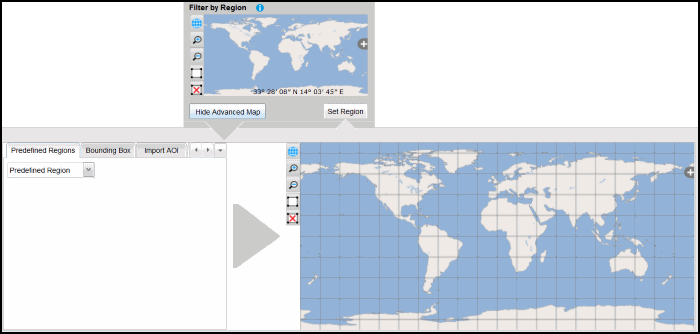
There you can select a predefined region from the drop-down list.
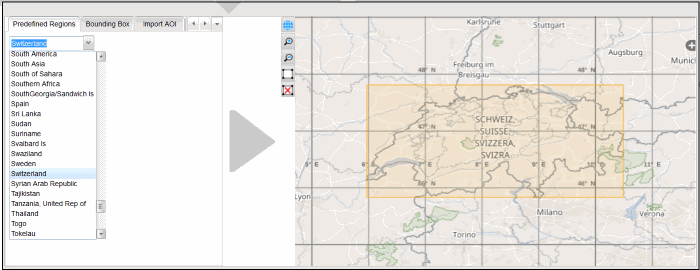
Or the coordinates for a bounding box will be inserted.
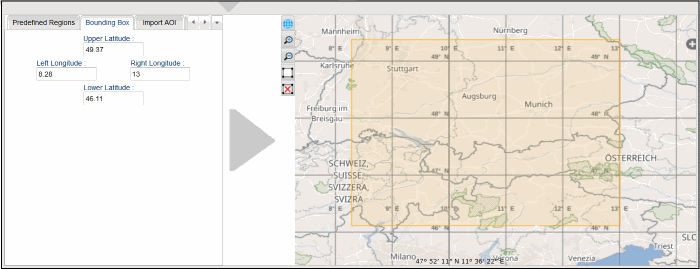
You can also import another AOI like shape file or kml file. The coordinates have to be specified using WGS84. The AOI is then set to the outer rectangle bounding box of the specified shape/kml (i.e. min/max latitude and min/max longitude).
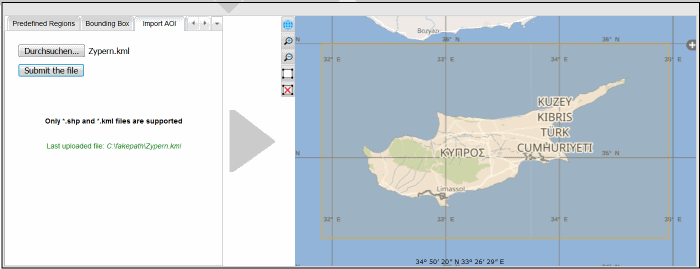
Perhaps you want to search a location.
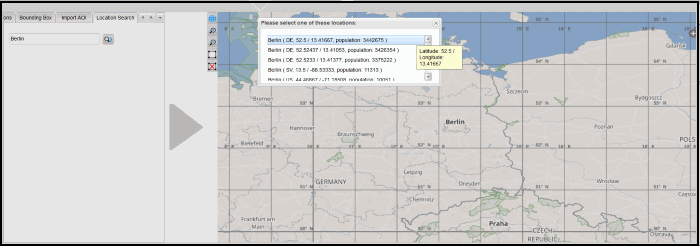
For all inputs, “Set Region” activates the region filter
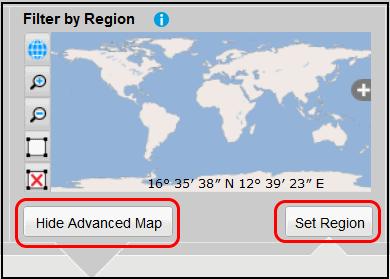
and the hide button closes the advanced map window again.
Filter by Time¶
You may also impose a time constraint on the catalog entries by selecting a date and/or time range using the date picker and time drop-down lists. Alternatively, the date can also be set directly by typing into the date fields.
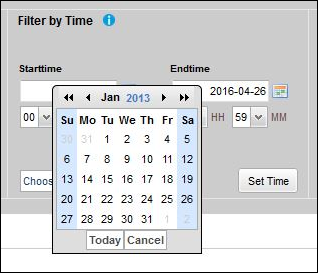
“Set Time” activates the date / time constraint.
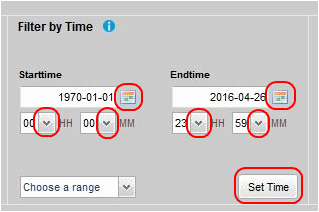
Choose range in a drop-down list.
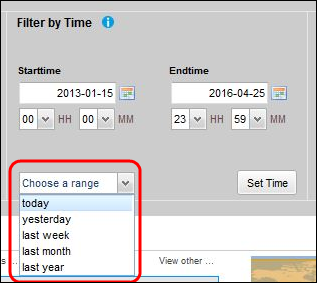
Filter by Type¶
This filter allows you to restrict the displayed catalog entries to a single type of metadata:
- Datasets: products and mosaics
- Dataset Series: collections of products
- Services: web services for geographic data
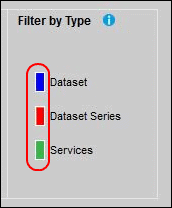
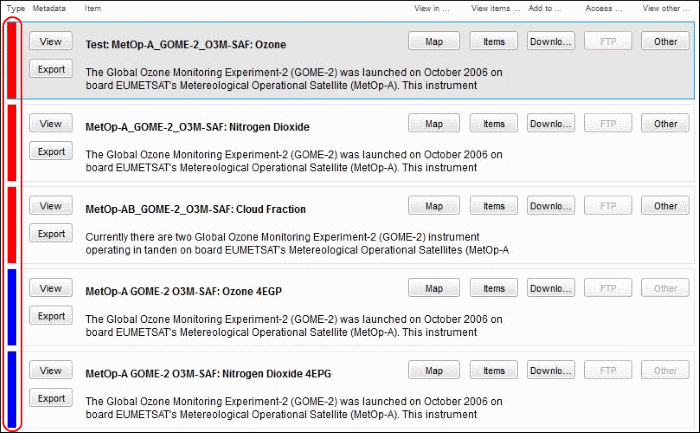
“Type” is a special filter which is applied immediately when one of the alternatives is selected.
Clicking on the blue Dataset will hide the green Service and red Dataset Series catalog entries.
Filter Management and Sorting¶
The situation depicted below shows the Catalog tab with all filters active and consequently with only four Dataset entries left. You also see four filter deactivation buttons.
You may deactivate a filter independently from the other filters in order to receive more Catalog entries. Or you may reactivate it with other constraints.
Pushing the “Clear Filters” button deactivates all filters.
You may save the currently active filter constellation for later reuse, load (i.e. activate), or delete a previously saved filter constellation.
Sort the list Catalog entries by selecting from the “Sort By” menu.

The “Hide Filter Gallery” button saves screen space but leaves the filter setting unchanged.
Push “Show Filter Gallery” to redisplay the filter settings.
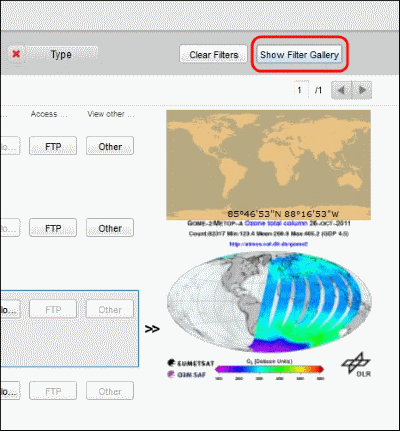
The EOC Catalog Entries List¶
In the EOC Catalog entries list, there is always one entry selected (the one with grey background) with an extent overview map and a preview image attached to the right. Only the preview for the selected item is shown.
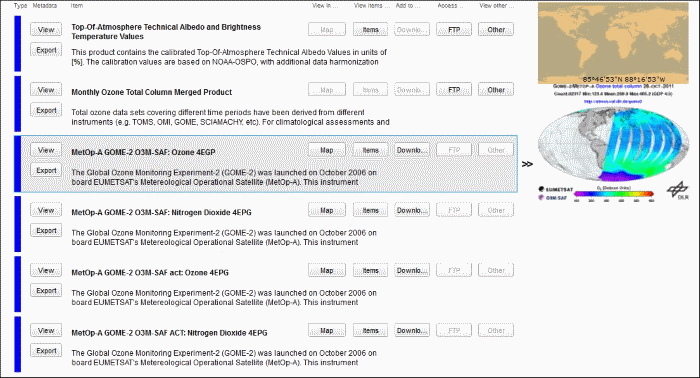
For the selected item you may have multiple options of what to do with this item, depending on item type and user permissions. The operations are:
- View: A metadata overview.
- Export: The complete ISO 19139 XML-encoded INSPIRE/GDI-DE/ISO-19115(2003) compliant metadata.
- Map: To display a high resolution image (WMS layer) of the item on the Map tab.
- Items: To find and explore single datasets of the selected dataset series.
- Download: Opens a page with the download options of this item. Following this track you will finally download georeferenced EO products from a Web Coverage Service (OGC WCS, see https://www.opengeospatial.org/standards/wcs)
- FTP: To download data products via ftp.
- Other: To access other resources.
View¶
You may view an abbreviated structured description of the selected item by clicking the “View” button.
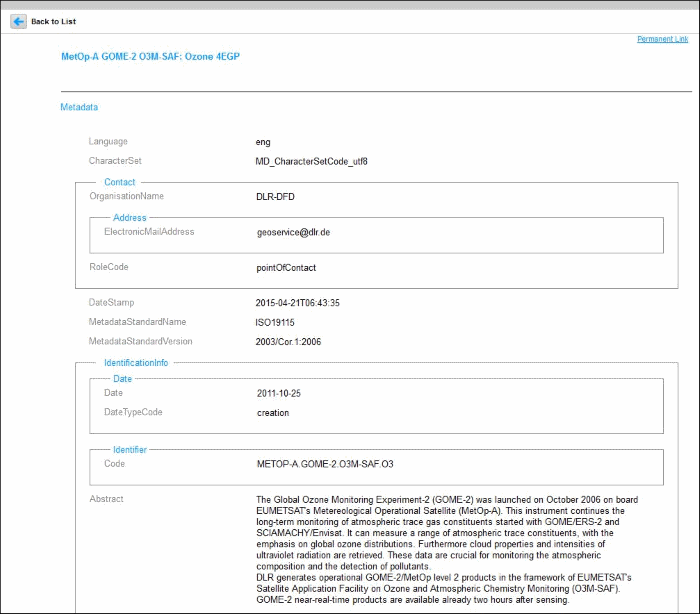
To get print form of this view, click permanent link and then print.
Export¶
If you want to see the full ISO 19115/19139 XML metadata click on “Export”. This will open a new web browser window or tab. If you open the source XML it will look like
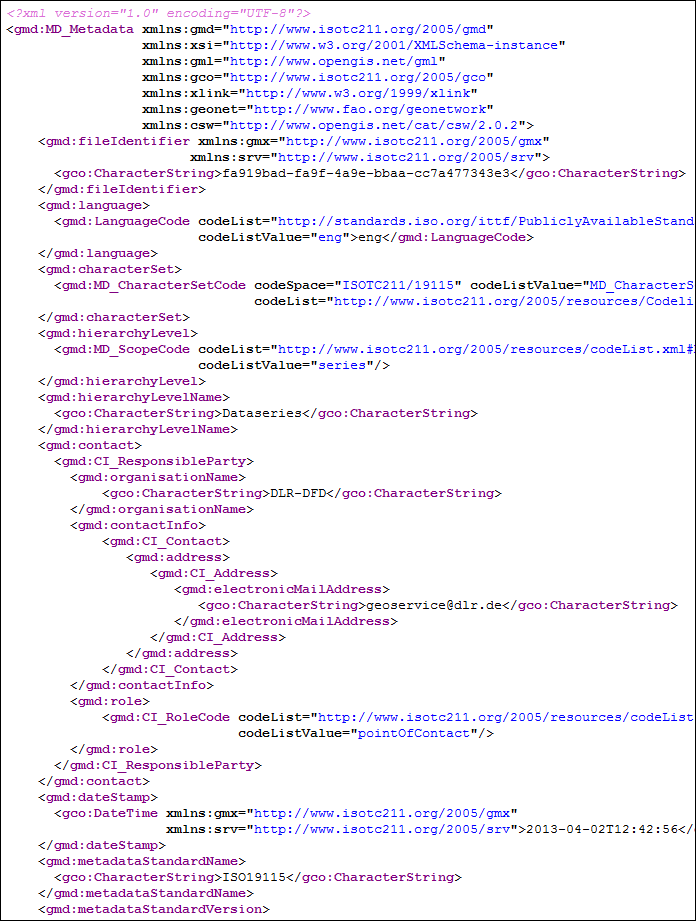
Map¶
If you push the “Map” button, a high resolution map image of the selected item will be displayed on the Map tab. For more information on using the Map please refer to Exploring Map Features.
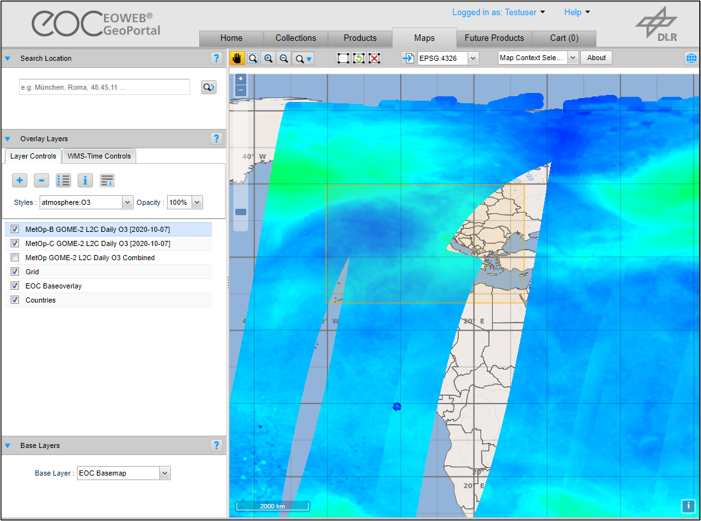
Items¶
Pushing the “Items” button changes the view to the Products tab. Here you can find individual datasets of the selected dataset series. For more information please refer to Find and Order Single Datasets of a Dataset Series.
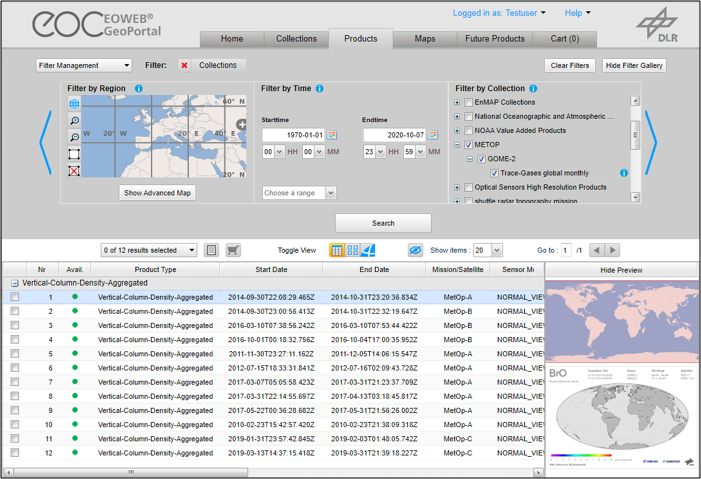
Download¶
The most important option is to click the “Download” button, which brings up the entry page for the EGP ordering process.
FTP¶
For downloading data products via ftp, press the “FTP” button.
Other¶
The last option remaining is to click the “Other” button, which means to access other resources.
Set Download Options¶
You may specify the download product by selecting the region to download, by setting any other selectable option on this form and clicking the “Add to Order” button. This creates a new order with one order item which you can extend by repeating this process.
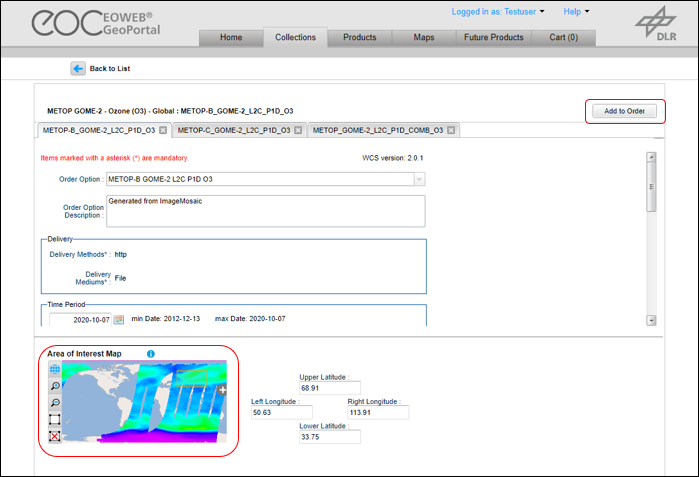
Also a popup box appears asking you if you want to continue with specifying products and adding them to your order (done one more time in this example, as you will see) or if you want to enter the next step towards the download, opening your shopping cart, i.e. the Cart tab.
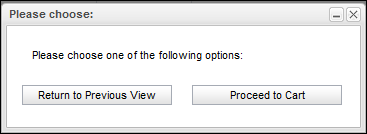
The Cart Tab¶
The Cart resides in its own tab so you can easily open it from anywhere in EGP. If you proceed to the Cart you will see a list of order items.
Click on the “X” (close) button to remove an order item from the cart.
You may also click on the “Catalog” tab and add more order items.
Order Catalog Entries¶
If you want to modify an order item, then click on the respective “Specification” button.
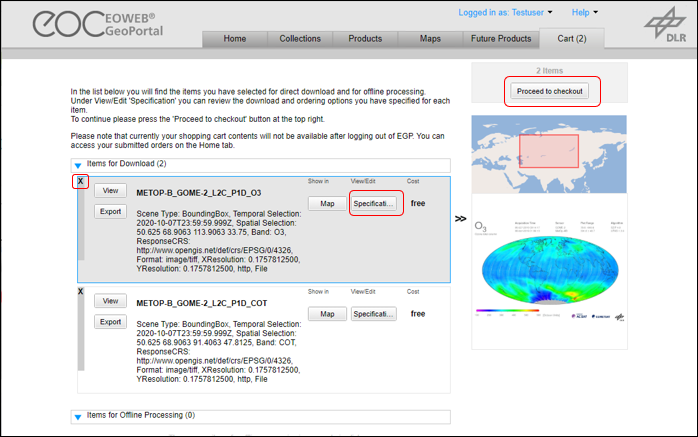
When you are finished, click on the “Update Order” button to return to the order item list.
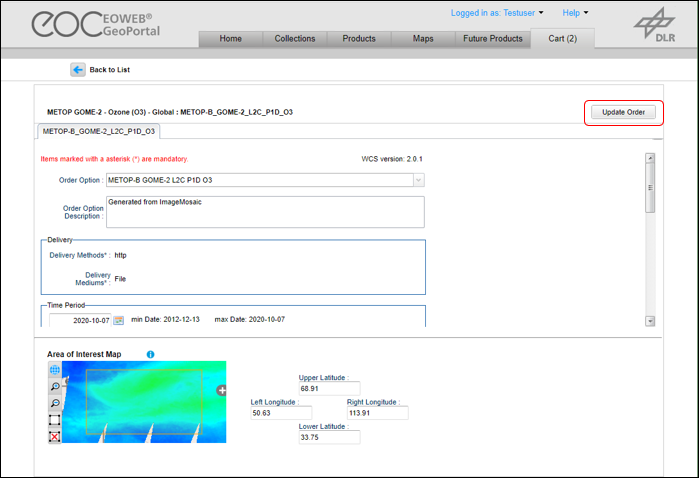
If your order is complete, then “Proceed to checkout”.
Next you are asked to accept one or more license agreements. Accept the license agreements by clicking on the check boxes and continue to the “Submit” form.

Here you can check your order, give your order a name, and submit it.
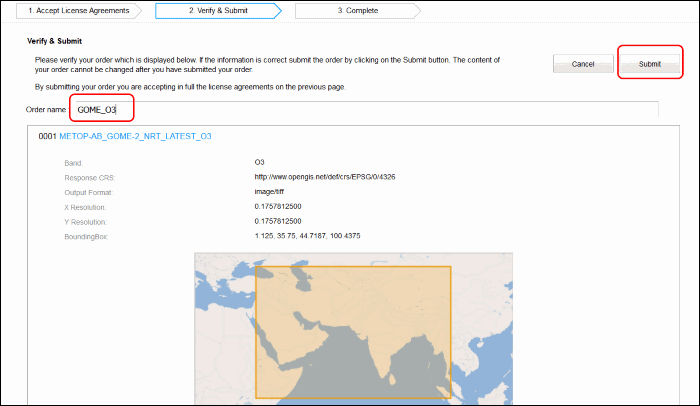
After successful submission, your cart is empty and your order details have been stored by EGP. In addition there is a “Download” button for each product. When you click these, a download request for the specified products is issued on each click. You are requested to open or save the resulting product file for each request.
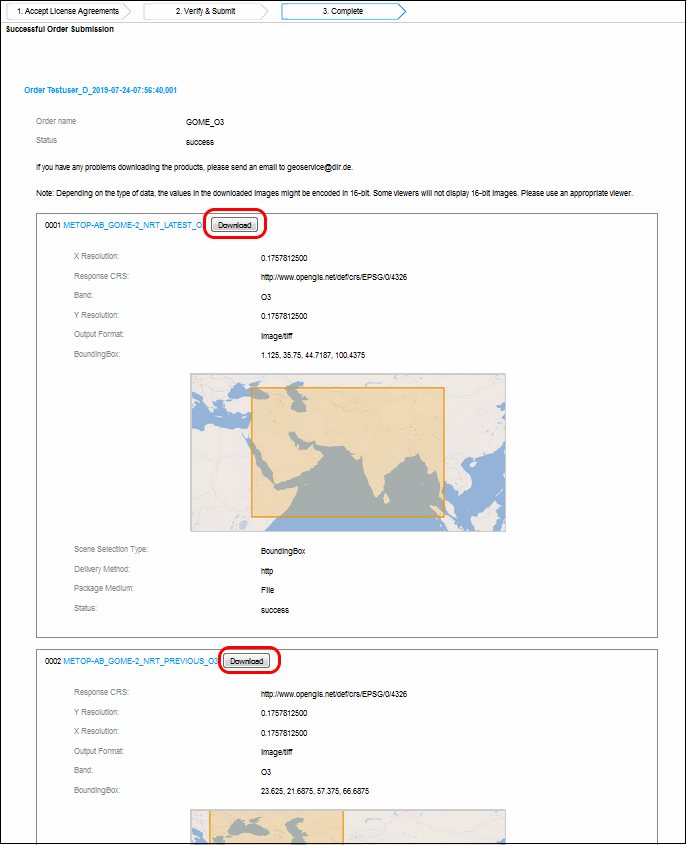
Clicking the “Ok” button will bring you to the EGP Home tab where you have access to your order details. It is, however, not guaranteed that your download(s) will still be available.
Repeat Order¶
To repeat order, go to home tab (see chapter 2) and see on the right hand side in the box “Your Items”, where you can access your old orders. Clicking “more...” leads you to a dialog, where you can set a time range for the orders you want to search for. The Search outputs a list of your orders. Click on any of the orders to get order info output and there you can press “download”-button again.
